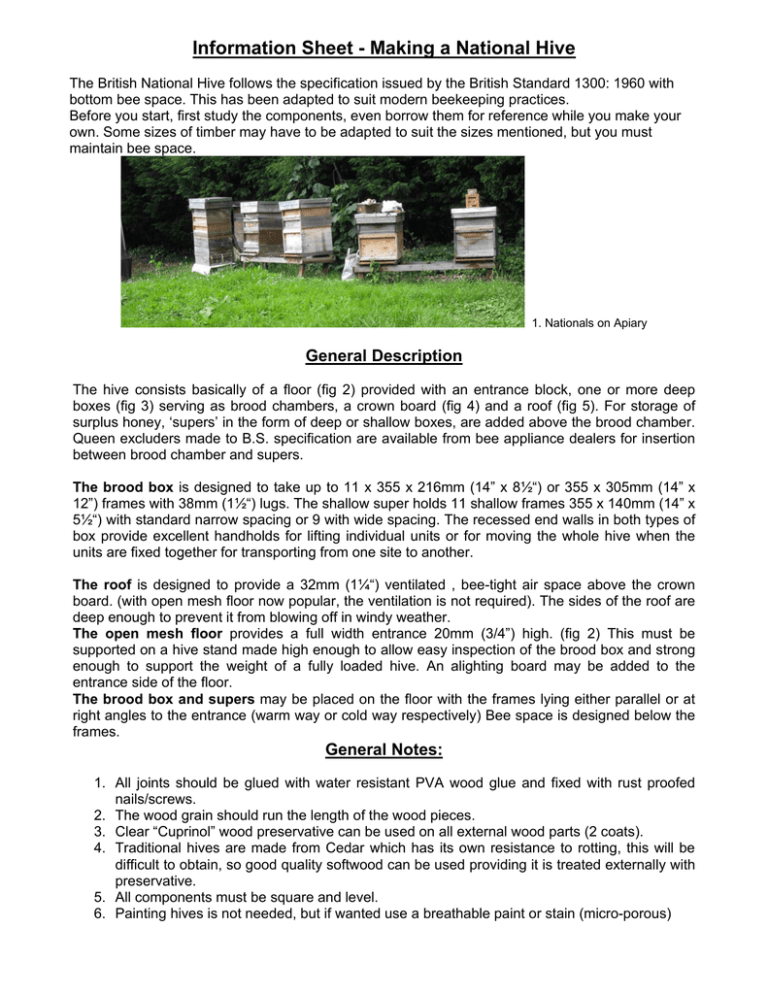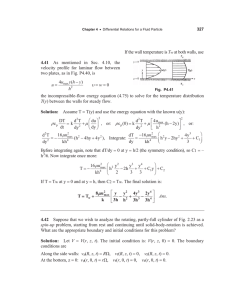information sheet - making a National hive
advertisement

Information Sheet - Making a National Hive The British National Hive follows the specification issued by the British Standard 1300: 1960 with bottom bee space. This has been adapted to suit modern beekeeping practices. Before you start, first study the components, even borrow them for reference while you make your own. Some sizes of timber may have to be adapted to suit the sizes mentioned, but you must maintain bee space. 1. Nationals on Apiary General Description The hive consists basically of a floor (fig 2) provided with an entrance block, one or more deep boxes (fig 3) serving as brood chambers, a crown board (fig 4) and a roof (fig 5). For storage of surplus honey, ‘supers’ in the form of deep or shallow boxes, are added above the brood chamber. Queen excluders made to B.S. specification are available from bee appliance dealers for insertion between brood chamber and supers. The brood box is designed to take up to 11 x 355 x 216mm (14” x 8½“) or 355 x 305mm (14” x 12”) frames with 38mm (1½“) lugs. The shallow super holds 11 shallow frames 355 x 140mm (14” x 5½“) with standard narrow spacing or 9 with wide spacing. The recessed end walls in both types of box provide excellent handholds for lifting individual units or for moving the whole hive when the units are fixed together for transporting from one site to another. The roof is designed to provide a 32mm (1¼“) ventilated , bee-tight air space above the crown board. (with open mesh floor now popular, the ventilation is not required). The sides of the roof are deep enough to prevent it from blowing off in windy weather. The open mesh floor provides a full width entrance 20mm (3/4”) high. (fig 2) This must be supported on a hive stand made high enough to allow easy inspection of the brood box and strong enough to support the weight of a fully loaded hive. An alighting board may be added to the entrance side of the floor. The brood box and supers may be placed on the floor with the frames lying either parallel or at right angles to the entrance (warm way or cold way respectively) Bee space is designed below the frames. General Notes: 1. All joints should be glued with water resistant PVA wood glue and fixed with rust proofed nails/screws. 2. The wood grain should run the length of the wood pieces. 3. Clear “Cuprinol” wood preservative can be used on all external wood parts (2 coats). 4. Traditional hives are made from Cedar which has its own resistance to rotting, this will be difficult to obtain, so good quality softwood can be used providing it is treated externally with preservative. 5. All components must be square and level. 6. Painting hives is not needed, but if wanted use a breathable paint or stain (micro-porous) 7. For brood boxes and supers, plywood can be used for the walls, but are much heavier than softwood. For brood boxes holding 14 x 12 frames, plywood will probably be best as softwood of this size tends to be unstable, splitting and warping. Specification FLOOR (fig 2) The dimensions of the floor are 460 x 460mm x 43mm. 20 x 20mm softwood is used for the top frame with halved joints using small screws and glue. The lower frame to be out of 20 x 44mm on 3 sides, the back piece being 20 x 20mm. The frames are screwed and glued together, sandwiching the mesh between them. The mesh must be either galvanised or nonferrous metal and of a small enough mesh size to stop bees and wasps from getting through. (Bee appliance dealers sell this cut to size) To support the varroa insert (corrugated plastic – estate agent’s sign!) use as used for small timber strip such a the bottom bars of a frame, nailed to each internal side. Entrance block is 417mm long x 19mm x 19mm with a slot cut into one side to allow entry/exit of the bees (if this is 4.5mm high, it will stop mice gaining entry.) To prevent the block being pushed in too far, a staple fixed to the inner face of the floor sides, projecting about 6mm fits the bill. Please note: I advise that you get a ready made floor to help understand its construction. 2.Open mesh floor BROOD CHAMBER (fig 3a & 3b) The outside lateral dimensions are 460mm x 460mm; the depth for a “standard” brood box is 225mm and for 14” x 12” frames the depth is 315mm. All 4 walls are made of 20mm finished softwood (plywood can be used, but is heavier). The end walls are 432 x 202mm (432 x 291mm for the 14” x 12”s) and are let into the side walls to a depth of 5mm, 25mm from the each end. This 25mm space between the outside surface of each end wall and the end of the side walls is closed with two fillets, one at the top and one at the bottom. The top fillet is rebated on the inside 18mm deep from the top edge, leaving a shoulder 12mm wide. This rebate forms part of the recess which encloses the ends of the frame lugs. The bottom fillet is rebated on the underside to a depth of 6mm leaving a shoulder of 12mm. This provides the bee-space above the lugs of frames in any box below. The upper suface of the bottom fillet is chamfered to shed rain. The frame lugs are raised above the rebates of the top fillet on runners. These are set with their top edges 11mm below the top edges of the side walls of the box. A good method of constructing the ends of the box is illustrated in Fig 3 where the top and bottom fillets are attached to the side walls by tenon joints. These joints should not be cut less than 18mm from the top and bottom edges of the walls respectively. Further details of construction are shown in Fig 3b. SHALLOW SUPER (fig 3a & 3b) The dimensions and construction are the same as for the brood chamber except that the depth is 150mm Please note: The depths specified for the brood chamber and the shallow super provide a bee-space of 9mm below the frames, which is the maximum that can be permitted if the building of burr comb by the bees is to be avoided. This allows for a slight shrinkage of the wood. It is most important to use well seasoned timber to ensure that the bee-space is not reduced to below 6mm by excessive shrinkage in the width of the boards after they have been cut to the specified size. CROWNBOARD (fig 4) The dimensions of the crownboard are 460 x 460mm. Recommended materials are 6mm resin bonded plywood with 20 x 8mm softwood batten edging on both sides providing the necessary bee space. The board needs 1 or 2 openings (30 x 76mm) adapted to receive Porter bee escapes, one centrally and the other parallel and 76mm away from the edge of the board. ROOF (fig 5) The inside dimensions of the roof are 477 x 477mm x 145mm deep. The top can be either 9mm thick t & g softwood boards or 9mm resin bonded plywood and the sides at least 15mm thick. The corners of the sides should be securely jointed and nailed in both directions. The roof must be covered with non-rusting sheet metal or other waterproof material extending at least 40mm down the side. (a hot smoker can burn through some other products!!) Four continuous strips of 32 x 19mm are fixed around the inside top to provide a head space of 32mm above the crownboard. NB: with open mesh floors, no roof ventilation is needed. Assembly (use water resistance glue + rust proof nails/screws for joints) Open Mesh Floor: Cut all seven parts to 460mm length before forming joints. 20 x 20mm and 20 x 44mm softwood is a standard wood size. The entrance block should be measured & cut when the floor is complete. Make the under frame fist, gluing and screwing the corners. The mesh should be stapled at each corner and along the exposed front edge. Then add the upper 3 parts using 38mm screws, making sure the heads of the screws are recessed. Brood Boxes & Supers: Fit the end walls into the grooves in the side walls and nail through the grooves, making sure that the end walls finish 6mm short of the side walls at the bottom and that the runners for the frame lugs lie 11mm below the top edge of the side walls. Fit and nail the four rebated end fillets, the chamfered ones at the bottom. Roof: Assemble and nail the 4 lock jointed wall. Fix the 4 strips inside around the top. Nail on the plywood top making sure that the whole assemble is square. Fit the waterproof cover and secure with galvanized nails round the sides.


